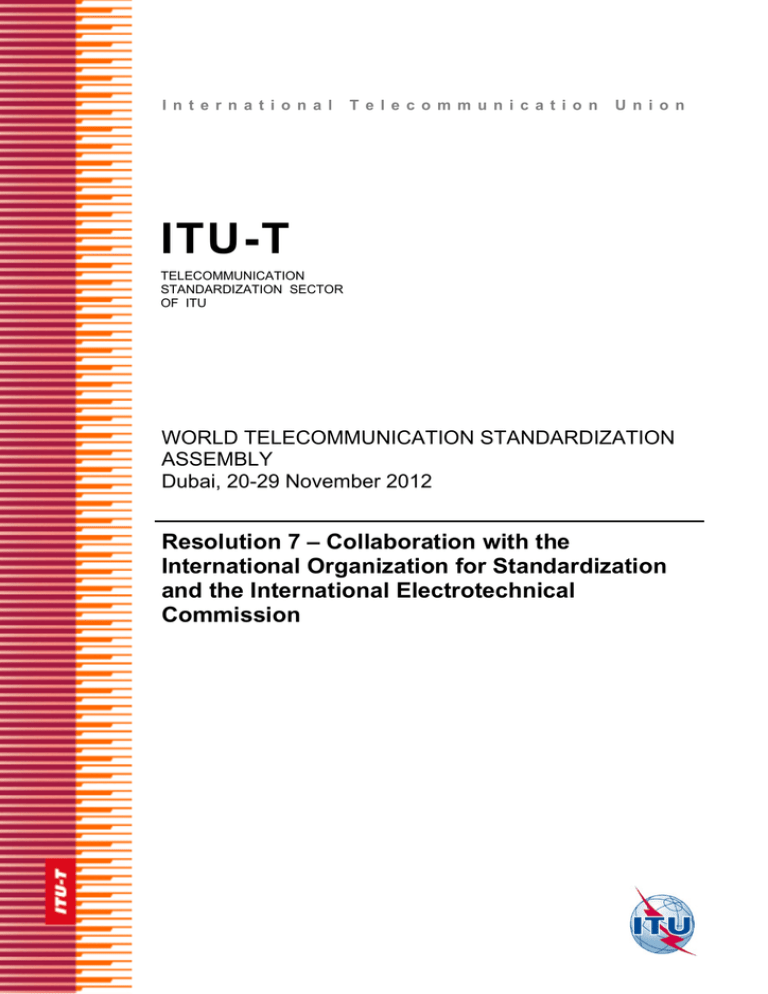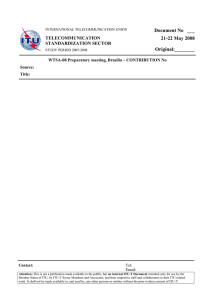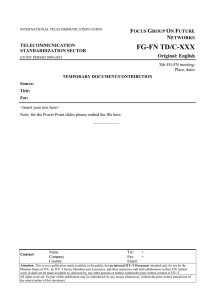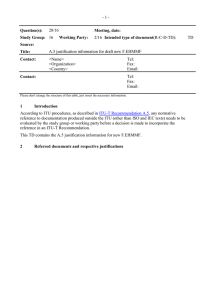
I n t e r n a t i o n a l
T e l e c o m m u n i c a t i o n
U n i o n
ITU-T
TELECOMMUNICATION
STANDARDIZATION SECTOR
OF ITU
WORLD TELECOMMUNICATION STANDARDIZATION
ASSEMBLY
Dubai, 20-29 November 2012
Resolution 7 – Collaboration with the
International Organization for Standardization
and the International Electrotechnical
Commission
FOREWORD
The International Telecommunication Union (ITU) is the United Nations specialized agency in the field of telecommunications. The ITU Telecommunication Standardization Sector (ITU-T) is a permanent organ of ITU. ITU-T is
responsible for studying technical, operating and tariff questions and issuing Recommendations on them with a view to
standardizing telecommunications on a worldwide basis.
The World Telecommunication Standardization Assembly (WTSA), which meets every four years, establishes the
topics for study by the ITU-T study groups which, in turn, produce Recommendations on these topics.
The approval of ITU-T Recommendations is covered by the procedure laid down in WTSA Resolution 1.
In some areas of information technology which fall within ITU-T's purview, the necessary standards are prepared on a
collaborative basis with ISO and IEC.
ITU 2013
All rights reserved. No part of this publication may be reproduced, by any means whatsoever, without the prior written
permission of ITU.
RESOLUTION 7 (Rev. Dubai, 2012)
Collaboration with the International Organization for Standardization
and the International Electrotechnical Commission
(Malaga-Torremolinos, 1984; Helsinki, 1993; Geneva, 1996; Montreal, 2000;
Florianópolis, 2004; Johannesburg, 2008; Dubai, 2012)
The World Telecommunication Standardization Assembly (Dubai, 2012),
considering
a)
the purposes of the Union set forth in Article 1 of the ITU Constitution relating to the harmonization
of telecommunication facilities;
b)
the duties of the ITU Telecommunication Standardization Sector (ITU-T) as set forth in Chapter III
of the Constitution;
c)
the interest of both the International Organization for Standardization (ISO) and the International
Electrotechnical Commission (IEC) in certain aspects of telecommunications;
d)
the common interest of ISO and IEC on the one hand and ITU-T on the other in the development of
standards on telecommunication and information technologies, on cables, wires and optical fibres and on
protection measures which take full account of the needs of manufacturers, users and those responsible for
communication systems;
e)
the need for mutual agreements on other areas of standardization activity of common interest, along
the lines of cooperation in the field of telecommunication security between ITU-T Study Group 17 and its
counterparts in ISO and IEC;
f)
the increasing relevance of the ITU conformance and interoperability programme, which has,
among other objectives, recalled that ITU-T Recommendations should consider, when applicable, laboratory
test procedures able to assess requirements standards confidently,
noting
a)
that the working methods and timing constraints of the organizations concerned are not the same;
b)
the increasing demands on financial and specialized professional experts in both telecommunication
technology and operations as well as computer science and terminal manufacturing and testing;
c)
the coordination meeting newly established between the three organizations through their top
management;
d)
the progress made on the basis of existing procedures in the alignment of technical
Recommendations with ISO, IEC and ISO/IEC Joint Technical Committee 1 (JTC 1) in areas of joint
interest, thanks to the excellent spirit of cooperation which has prevailed;
e)
the principles of collaboration established between ISO and IEC and particularly with ISO/IEC
JTC 1 on information technology as contained in Recommendation ITU-T A.23 and in the ISO/IEC JTC 1
Directives;
WTSA-12 – Resolution 7
1
f)
that other standardization activities of a collaborative nature may require coordination;
g)
the increasing cost of developing international standards,
resolves
1
to continue inviting ISO and IEC to examine the ITU-T study programme in the early stages of its
studies and vice versa, and to further examine such programmes to take into account ongoing changes, in
order to identify subjects where coordination seems desirable, and to so advise the Director of the
Telecommunication Standardization Bureau (TSB);
2
to request the Director of TSB, after consultation with the study group chairmen concerned, to
reply, and to furnish any additional information requested by ISO and IEC, as it becomes available;
3
to request the Director of TSB to examine and update the programme of cooperation and priority of
the study items among ITU-T, ISO and IEC and highlight this information on the ITU-T website on a regular
basis;
4
to request the Director of TSB, the study groups and the Telecommunication Standardization
Advisory Group to consider and propose further improvements to the procedures for cooperation between
ITU-T and ISO and IEC, including setting the priorities for such cooperation, such as conformance
assessment schemes and laboratory standards;
5
that the necessary contacts with ISO and/or IEC should be at the appropriate levels and coordination
methods should be mutually agreed and regular coordination events arranged:
•
for work where text should be drawn up mutually and kept aligned, procedures in accordance with
Recommendation ITU-T A.23 and the Guidelines for Cooperation therein apply;
•
for other activities where coordination between ITU-T and ISO and IEC is required (for example in
relation to any mutual agreements, such as the Memorandum of Understanding on standardization
in the field of electronic business), clear means of coordination shall be established and regular
coordination contacts made;
6
to request the chairmen of study groups to take into account the related work programmes and the
progress of projects in ISO, IEC and ISO/IEC JTC 1; further, to cooperate with these organizations as widely
as possible and by appropriate means, in order to:
•
ensure that the specifications which have been jointly drawn up remain aligned;
•
collaborate in drawing up other specifications in fields of joint interest;
7
that, for reasons of economy, any necessary collaborative meetings take place as far as possible in
association with other meetings;
8
that the report concerning such coordination indicate the status of alignment and compatibility of
draft texts on points of common concern, in particular identifying any subject which could be dealt with in a
single organization, and cases where cross-referencing would be helpful to users of published International
Standards and Recommendations;
9
to invite administrations to contribute significantly to the coordination between ITU-T on the one
hand and ISO and IEC on the other by ensuring adequate coordination of national activities associated with
the three organizations.
2
WTSA-12 – Resolution 7




